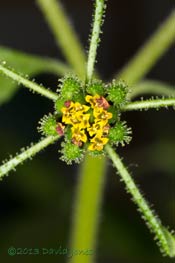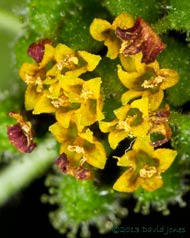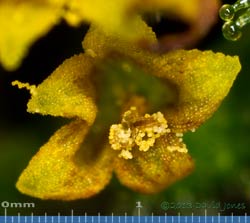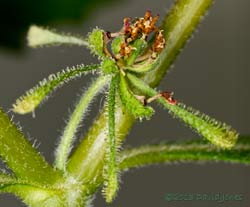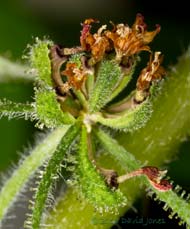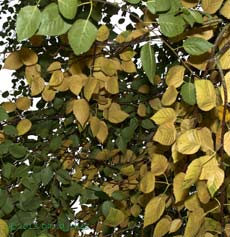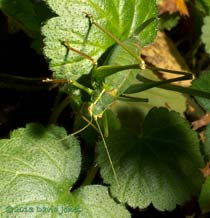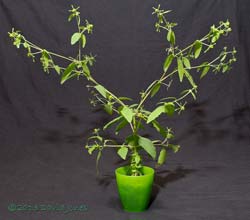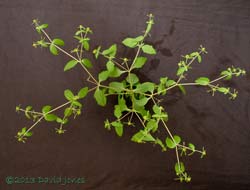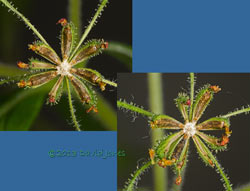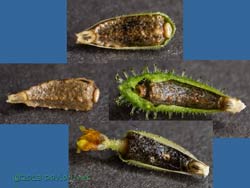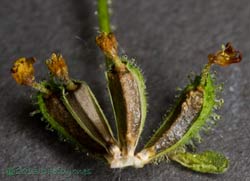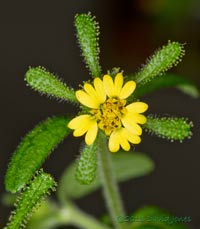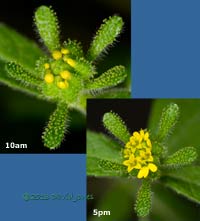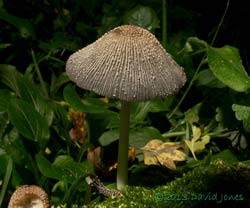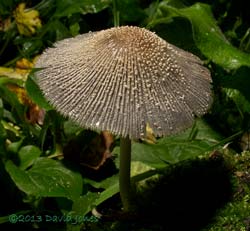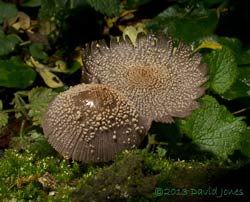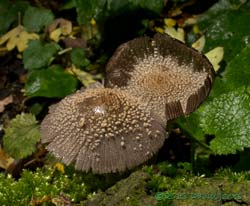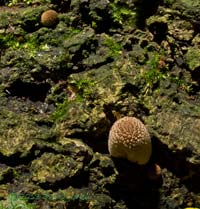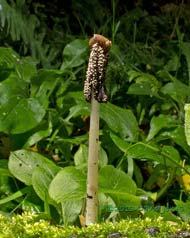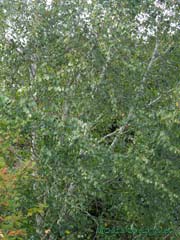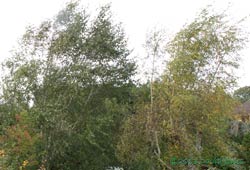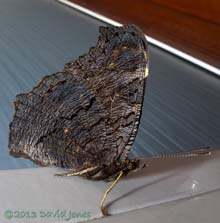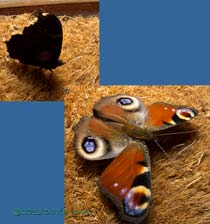Go to the last entry on this page .....Go to previous entry
6 October - I seemed to have missed the start of the month as time flew by, with what seems like so much too be done and clocks that move too quickly! October has had a largely grey and relatively mild beginning and with some mist but very little in the way of rain. For a (pleasant) change, this morning is cloudless and the temperature has dipped below 10C. The mystery plant continues to grow and produce its intriguing flowers. My search for its identity online has still to succeed. I have found some rather tenuous similarities with plants in the genus Holocarpha, the tarweeds of California, USA, and members of the daisy family (Asteraceae). There are just four species in this group, and while it is clear that they are clearly not close relatives of 'our' plant, they do suggest that I'm looking in the right direction.
Yesterday I took a few more photographs of the plant, concentrating on 'older' flowers.
At this stage the sepals(?) are each around 15mm long and the flower head 6 - 7mm across. The petals of the five ray flowers (florets) have by now turned a deep orange colour. The glandular structures are obvious all around the flower and show no sign of declining at this stage.
Looking more closely at the flower head I can see nine disc florets, each with its five fused petals.
It is clearly very sticky pollen, this property likely to be the reason for the curious 'string' of pollen extending out from the left of the floret. The scale suggest that the pollen grains measure around 0.025mm across.
Included in the previous set of images was a picture of what (I understand) was the first flower to appear. That was already further on in its development than the flower above, and by yesterday its component florets could be seen separating out.
Both flower types, ray and disc, continue to be protected(?) by globule bearing sheaths and so far I can see no sign of any seed production by this flower. At the moment I check the plant each day and when each new flower opens I brush it very gently with a very soft paint brush in the hope that we can get the plant to produce seeds that we can compare with the others (presumably Venus Flytrap!) that remain unused.
Returning to our own garden, today the temperature reached 19C by 4pm as we enjoy a mild spell which is likely to be replaced by cold weather later in the week.
Autumn is really underway now with the Birch showing great contrasts in leaf colour from one branch to another. While leaves are still a rich green on some, on others they are a golden colour, ready to fall at the slightest breeze. On the Hawthorn the change seems more haphazard with small patches of gold amongst what is still mainly green foliage.
7 October - No photographs today, just a note to record that it was a largely sunny day with a high of 18c which was maintained for much of the afternoon.
13 October - Well, Autumn is well and truly here. Temperatures dropped to the lower teens mid-week, and today we have had a dull, wet day. Just about better late than never, and with the prospect of today's bad weather hanging over me, during the second half of the week I finally got around to doing some long overdue repairs to my workshop shed. A couple of years ago I foolishly rested some roofing panels leaning against two exposed walls of the shed. When I finally got around to moving them this summer I found that some of the shed planking had rotted where water had been trapped. Once they had dried out I put up some tarpaulin sheets to protect the shed walls but it is only now that I'm finally remedying the damage. I have a bit more to do which will be completed later this week. As well as the actual repairs being done I also treated the timber on the three exposed walls of the shed so that it should survive the winter! That job took priority over the rest of the garden and before I have chance to start its autumn clear-up I have another urgent task to carry out. Our caravan shelter cover has succumbed to UV light and needs replacing. A large, heavy duty tarpaulin should arrive during the week and as soon as possible I'll be covering the shelter with it to see us through the winter. I hope to dispose of the caravan during the winter. Once it has gone the shelter will be be reduced in size, nearer to carport dimensions and with a more robust roof. I may not be paying much attention to the garden at the moment, but that potted plant continues to fascinate. I've made no further progress towards identifying it but I'm seeing the first seed pods (or seeds?) being shed. This adds a sense of urgency to the identification issue as I do not want to allow the seeds of an unidentified alien plant to escape into the wilds of our garden. At the moment the plant is standing on a tray, but with its branches now extending at least 45cm across I think that a high sided container may be more secure! While there are still new flowers opening, two of the early blooms are now in the process of shedding the components of the compound structures, including the seeds as well as the long 'sepals'. I'll add some pictures as soon as I can.
18 October - A cloudy day with just a touch of dampness from time to time, and a high of 17C. The caravan shelter continues to wait for its new cover, which is sitting on our veranda - that job may get done this weekend, weather (and me) permitting! I also need to finish the repairs to the shed, although that will probably wait until the latter half of next week. This morning I wasted a couple of hours trying to find a dimmer switch that is compatible with the LED light that I want to put into the bedroom used by our grandson - it seems that an apparent lack of standards regarding LED lighting is too much for local 'experts' to cope with. I think I'll need to research the problem online. Before I return to the subject of the alien on our dining table, a picture of a native species under our Birch tree this afternoon - an adult female speckled Bush Cricket which was very active amongst the low plants around the base of the tree. This species is active into November so I hope that I can spot one when our grandson is with us again in a couple of days.
Well, the alien plant remains a mystery with no suggestions forthcoming, and my searches continuing to be fruitless.
It is now around 33cm tall,
and its symmetry means that it measures about 47cm across at its widest, by about 32cm.
As I mentioned in the previous entry, after the first flower, it was the turn of the opposing pair of flowers that had flowered next to shed their seeds. At the moment it is the next four flowers that are on the verge of dropping their seeds. Two of them are shown here, appearing to show mixed success in producing those seeds.
When the seeds are released they usually remain cloaked in the sheath that surrounded the flower, and which still bears the sticky structures. Could these now play a part in getting the seeds carried away by animals or on wind-blown materials on the ground? I'm assuming that each of these is/contains a single seed. They measure just over 3mm in length and seem to match the seeds that Simon planted, although he didn't look closely at those.
When the seeds fall, some of the long 'sepals' are also shed. You can see a bit of one behind this cluster. Also, notice how one of the seeds(?) has a smooth surface as opposed to the wrinkled texture of the others.
At the extremities of the branches the plant continues to produce new flowers, although these are noticeably smaller,
and as they open it is the disc florets that are opening first, before the petals of the ray florets develop. This pair of images, taken 7 hours apart show what I mean.
Before I forget, the plant isn't the only alien in the house tonight. During the day I captured two Harlequin Ladybirds in our bathroom during the day - quite a surprise when I think about how few I have seen here all year!
19 October - a day with some blue skies interrupted by periods of just a slight dampness in the air and a high of 17C - and an afternoon of brightness when our grand-daughters (plus mum and dad) came for lunch. I hadn't seen a frog in the garden this month, until the younger of the girls took me on an expedition down the path! And I saw several more after dark.
This afternoon I also spotted this fungal fruiting body on a rotting log which has lain undisturbed next to the small pond for more than a few years. I photographed it just before 9pm,
and again at 10pm. By now the cap had opened up more, was now measuring some 5cm across, and around the edge it was starting to split.
Further along the log, another cap had split even more by 9pm, with the resulting frill starting to curl up and darken.
An hour later the fringe had curled enough to fold back on itself and you can see the that the 'fringe' is also dark brown on the underside. The other cap in the photograph measured 25mm across.
Interestingly, when I use a front-silvered mirror to look under the first fungus that I photographed, while most of the gills are dark, around the rim they are almost white, suggesting that they are darkening gradually as the cap opens up. Notice that where the flesh of the cap is exposed in the splits it is white (as is the case with the young, half-eaten cap to the left of the picture.
A closer look at the rest of the log revealed numerous other fruiting bodies in the process of emerging. I will be interested to see what the log looks like in the morning. A look in my Fungus guide suggests that this is a species of Coprinus, although it doesn't seem to match any of the species descriptions exactly.
A follow-up the next morning - Unfortunately, some heavy overnight rain all but obliterated the visible fungal caps on the log, apart from the one described first in the entry above. Even in this case the cap had drooped completely, apart from the orange tinted tip which stood proud of the collapsed gill structure. Soon after I had taken this photograph the whole thing had drooped and fallen over.
27 October - An interesting day weatherwise as we await the arrival of the 'St. Jude's Day Storm' early tomorrow morning The wind from the south west has been blowing at 20 - 28mph all day, with gusts already in excess of 40mph. Some time before 7am tomorrow we've been warned to expect gusts in excess of 80mph! Monday is bin day and the truck usually arrives just before 7am, leaving me with the dilemma - do I or don't I put the bin out?! I see that in Devon a wind turbine has already been blown over - a case of the wrong sort of wind perhaps? It will be interesting to see how the large number of turbines that we now see on our trips to the West Country with cope with the really strong winds expected tonight. While the jet stream continues to drag in mild air we have only needed to resort to the central heating for brief sessions on a few mornings and evenings so far, although it has begun to cool down over the last few days. Today, the outside temperature has risen from a low of 12C before breakfast to a high of 15C in the early afternoon. I have spent part of today taking precautions in the garden in readiness for the high winds. When the infamous 1987 storm hit I came home from work to find the roof of someone's car port sitting in the garden, and tiles lost from our house roof.
Back at the start of the month I commented on how the leaves on our Himalayan Birch tree has started to change colour. While that was true at the time, the process did not continue for more than a week or so. Those leaves were shed, and with the majority of the foliage still in place the tree looks green again. This picture was taken this afternoon. The red leaves in the bottom-left corner are on the Rowan.
In contrast to our Birch, the neighbour's native Birch (on the right in this picture) has a much more autumnal hue as it sheds its foliage.
When I returned indoors this afternoon there was a surprise awaiting me on our front door. It was a fresh looking peacock butterfly, resting on the frame at the bottom of the door.
This was repeated a number of times whenever it felt threatened, and I can see how the noisy appearance of the four large 'eyes' could prove a useful deterrent to a would-be predator. Here is a sound recording of such a sequence (it lasts just over 30 seconds and has a file size of 565KB). Each burst of sound represents a wing opening event. The wing closure that followed immediately afterwards was silent. A small Sony ECM-55B microphone was placed just in front of the butterfly - you may also just be able to make out the sounds of a dishwasher in the background! I cropped slightly a couple of the longer silent periods to reduce the overall length of the recording.
Once I'd captured that sequence I provided the Peacock with a honey drink, which it accepted with enthusiasm before moving it to my workshop shed where it should be safe as the storm passes over, and there are plenty of places for it to hide away for the winter as well as a way out should it choose to leave. Returning to the alien on our dining table, there is still no news on its ID. It continues to drop a couple of seeds each day, and I see another new flower has opened today. I can't end this entry without a mention of our grandson who was with us all of yesterday while his dad felled a very large Cedar tree. We had a fruitful bit of discovery time watching a couple snails moving about on a glass dish. Afterwards he carried the dish (with a lot of care) out onto the veranda where we watched as they lifted their shells over the side of the dish before sliding off into the darkness. And finally, Why St. Jude's Day storm. Monday is St. Jude's Day, if you believe in such things. St. Jude is the patron saint of lost causes, perhaps not the best person to watch over the country as tomorrow's storm passes over!
A late weather update - It looks as though the storm forecast is gradually being downgraded. I see that (as of 9pm) the Met Office prediction for us is suggesting wind speeds of no more than 28mph with gusts in the low 50's, not that much stronger than they were today. Hopefully it may mean that my grandson's dad will get a peaceful night - he is on standby to deal with fallen trees.
28 October - A bright, blustery morning, and a feeling that the storm largely passed us by with little more than a few fairly strong gusts. The only bits of evidence for its visit on our garden are the leaves scattered about, adding to what was already carpeting the ground, and the sparrow feeder which has taken on a slight lean to the north as a result of movement by the adjacent Burberis bush. At what was supposed to be the peak time for the storm at 7am, Farnborough airfield was recording gusts of fifty something miles per hour.
Click on images to see larger versions
|
|
